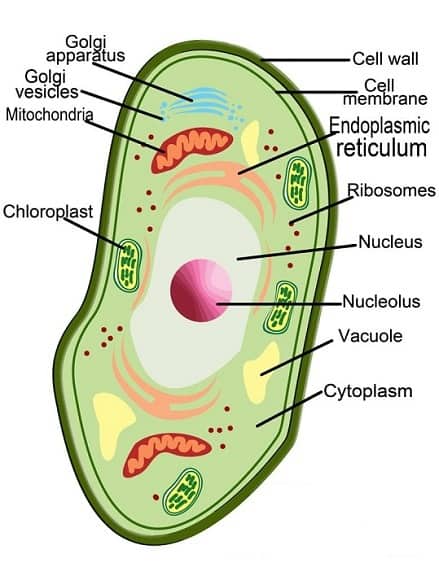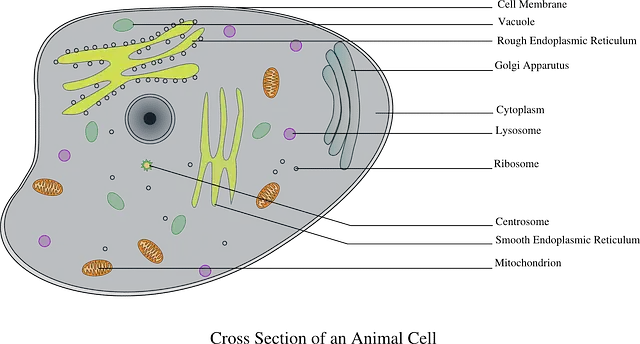Cell membrane and cell wall are both parts of a cell. But the cell membrane is an organelle having a life.
While the cell wall is a non-living structure. Both of them are present at the boundaries of the cell.
Their common role is to give protection to the whole cell and internal organelles in the cell. Further, both of them together form the cytoplasmic bridges.
These cytoplasmic bridges help in inter-cell communication and transfer.
Also, both of them are partly involved in cell division and exist from birth to death of the cell. But there are many differences between Cell Membrane and Cell Wall which we will see in a table below.
Differences between Cell Wall and Cell Membrane.
Before we go into details, check the two cells below. One is of plant cell and the other is an animal cell. A plant cell has a cell wall while the animal cell has no wall.

| Features | Cell membrane | Cell wall |
| Distribution | Cell membrane is present in all types of cells. i.e human, animal, plant, bacterial etc. | Cell wall is Present in only plant cells and bacterial cells. |
| Living nature | Cell membrane is an organelle of the cell. And is outermost cover in animals and humans. It provides shape to cell which is flexible. | Cell wall is the outer non-living cover of the cell but not an organelle. It encloses cell membrane. It also provides a fixed shape. |
| Composition | It is a lipid bilayer. And is made of lipo-proteins. | This is made of pectin, chitin, lignin etc. In bacteria it is made of glyco-proteins, glyco-lipds |
| Ductility | This has the ability to contract. It is flexible to change the shape as needed. | Cell wall is rigid with fixed shape. Any pressure application can break the wall. |
| Communication | Cell membrane has receptors to receive signals from external chemicals. | Cell wall lacks any receptors. |
| Appendages | In Bacteria, cell membrane gives rise to flagella (movement) and pilli (reproduction) like structures. | While cell wall facilitates flagella and pilli through small apertures. |
| Structural changes | It is of the same thickness in the whole life time of the organism. | The wall grows in thickness over time. Further, it occupies whole cell in plant as the cell ages and dies. |
| Physiological support | The membrane is permeable and controls the movement of substance into and outside the cell. That is, it can allow water and other substance to pass through selectively. | The cell wall is semi-permeable. It allows passage of substances with size of 30-60kD. |
| Role in cell | Cell membrane has functions like permeability, signal reception, motility (amoeba), conduction (nerve cell), cell division, sexual reproduction etc. | Cell walls only function is protection from external harsh environment. |
| Changes | Cell membrane requires nutrition from cell. So it shrinks during fast and drought conditions. | While cell wall is mere deposit of substances. So it does not need nutrition but mere deposition in case of damage. |
As you have learned till now, cell wall and cell membrane are meant to cover and protect the cell. But not all cells have both of them. The cell membrane is present in all the cells.
The cell wall is present in cells like that of bacteria, algae, fungi, and plant cells and absent in animal cells. The difference between the cell membrane and cell wall are quite a few yet worth reading.
These include
1. Composition
2. Structure
3. Role in physiology
4. Role in disease.
5. In stress and after death
Composition:
Cell membrane. This is mostly made of phospholipids, cholesterol, carbohydrates, proteins in most animal cells. In other cells like that of plants and bacteria, there are few changes instead of the cholesterol; there are sterol and lipopolysaccharides.
Cell wall, on the hand, varies in composition in different organisms. In bacteria, it is made of peptidoglycans, lipopolysaccharides, lipoproteins, etc. In algae, the cell wall is composed of glycoproteins and polysaccharides such as carrageenan and agar.
In-plant cells, the cell wall is made of cellulose, hemicellulose, pectin, etc. In older cells, there is an addition of even lignin in the cell wall to give rigidity. In animals, as mentioned earlier, there is no cell wall.
Structure: The cell membrane is a lipid bi-layer in most cell types. It is fluidic and adjusts according to the environmental conditions.
The cell wall is rigid and is made of chain-like structures of proteins and carbohydrates.
Role in physiology: Both cell walls and cell membranes are involved in cellular physiology to a certain extent. However, the cell wall has a comparatively little role than the cell membrane.
 Cell membrane helps in transport into and outside the cell. For this, it has transport proteins and other channels to facilitate the process. Further, the plasma membrane has receptors to receive signals from neurotransmitters, hormones, and other chemicals.
Cell membrane helps in transport into and outside the cell. For this, it has transport proteins and other channels to facilitate the process. Further, the plasma membrane has receptors to receive signals from neurotransmitters, hormones, and other chemicals.
The cell wall is mostly impermeable except for water molecules and ions. Instead, the cell wall of adjacent cells in plants form cytoplasmic bridges called plasmodesmata. Through these plasmodesmata, the essential cell constituents get exchanged in between cells.
Role in disease:
Defects or dysfunction in the cell membrane can lead to diseases. The cell membrane is involved in the movement of ions and other substances. Abnormalities, in its function, would lead to an imbalance in nutrition like aspects in the cell. If this problem exists in many cells, the whole organ can get damaged. Alzheimer’s disorder is one of the diseases caused by defects in the plasma membrane.
In stress: During the conditions of stress or harsh environmental conditions, both act to save the cell.
In the case of plant cells, the cell wall prevents the drying of the cell by inhibiting the evaporation of water from the cell.
The cell membrane forms blebs under conditions of stress. Sometimes these blebs act to protect the cell.
After cell death, the cell membrane is wholly digested like the rest of the cell. But the walls are not always destroyed. In plants, these cell walls are thickened to form channels like xylem and phloem. Xylem helps in the upward movement of water and other nutrients, while phloem helps in a downward movement of carbohydrates and other substances from the leaves.

The presence of a cell wall makes a huge difference in targeting bacteria in human and animal infections. This is used as a target to kill them, specifically by the use of anti-biotics without damage to animal cells. As per the taxonomy and evolution point of view, a cell wall’s presence is a primitive aspect.
With the advancement of life, the cell wall has become obsolete.
Check out The Functions of Cell wall in a plant cell.
But the other argument is for plants cell wall is essential. Because they are non-motile, they need cell walls to protect themselves from harsh conditions.
On the other hand, animals can run away from those conditions or make alternatives for protection like hiding in safety or covering themselves. So they may not need a cell wall.
Also, in the most primitive organism like bacteria, there is further protection on the cell wall in the form of a capsule. This is also an additional layer developed by them in times of drought conditions.
So we can conclude that the cell wall is a mere protection layer while the membrane is both a protective, structural as well as a physiological requirement.
how could a cell wall be impermeable? how would anything get in or out of the cell? that’s plainly wrong
@dave! Thanks for pointing out. The correction is done.